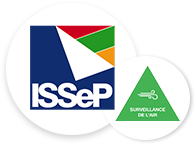European directives relating to air quality aim to harmonise its measurement or evaluation with the aim of preserving the ambient air quality when it is good and improving it in other cases.
The location of air quality monitoring network stations has been chosen in such a way as to cover areas where population density is high or where pollution problems with certain pollutants have been anticipated or proven. However, background sites or traffic sites do not have the same geographical representativeness; the extension of the area of validity of the former is much greater than that of the latter.
The direct use of measurements rather than the results of numerical simulations should therefore be taken with a pinch of salt when it comes to estimating personal or population exposure.
The approach chosen here is the combination of high frequency measurements (dt = 1 min) with simulation results at high spatial resolution (dx ~ 10m). To do this, we will use, on the one hand, portable AE51 type aethalometers measuring black carbon (black carbon, BC in English) through optical absorption and Antelope multisensor portable mini-stations developed by CECOTEPE ASBL. On the other hand, we will use the RIO-IFDM-OSPM modelling chain developed by VITO.
Moreover, in addition to taking into account the spatiotemporal variability at high resolution, we will try to bypass two other important simplifications often made in exposure studies:
-
population stagnation when many people do not work in the area where they live. The use of mobile phone data is an interesting source of information to assess the distribution of the population in space and in time; the SmartPop project conducted by ISSeP will derive population density maps for days, nights and weekends through these means;
-
link between indoor air and ambient air, and the exclusive use of the latter values when we spend most of our time locked in a building or a passenger compartment. A study by the EPA (US Environmental Protection Agency) shows that, on average, Americans spend 87% of their time in a building, 6% in a vehicle, and 7% outdoors. Similarly, Evi Dons showed that, on average, Belgian participants of their study spent 81% of their time in a building and 6% in a vehicle.
The project sheet is available on the ISSeP website : https://www.issep.be/wp-content/uploads/Projet-Micro-capteurs.pdf








